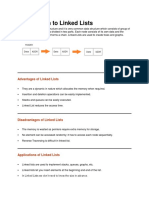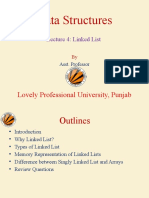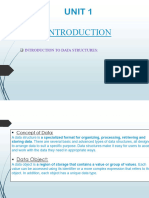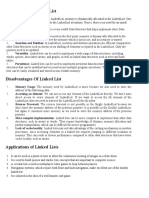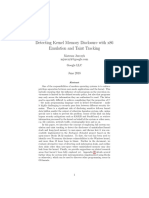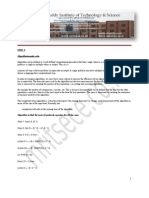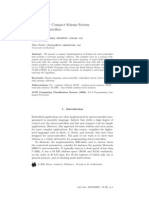Linked Lists: The Backbone of Dynamic Data Structures
Linked lists are a cornerstone of computer science, offering a flexible and efficient way to store and
manage data. Unlike arrays, which require contiguous blocks of memory, linked lists use nodes scattered
throughout memory, each pointing to the next. This design provides both advantages and unique
challenges, making linked lists a fundamental concept for any developer to master.
What is a Linked List?
A linked list is a linear data structure where each element, called a node, contains two parts:
• Data: The value or information stored in the node.
• Pointer (or Link): A reference to the next node in the sequence.
The first node is known as the head, and the last node points to null, indicating the end of the list[1][2][3][4].
Types of Linked Lists
Linked lists come in several variations, each suited to different scenarios:
Type Structure & Features Use Case Examples
Singly Linked Each node points only to the next node. Traversal is one-way, from head Simple stacks, queues
List to tail.
Doubly Linked Each node points to both the next and previous nodes. Allows two-way Navigable lists, undo-redo
List traversal. stacks
Circular Linked The last node points back to the first node, forming a loop. Useful for Round-robin scheduling,
List applications needing cycling. playlists
Linked Lists vs. Arrays
Understanding the differences between linked lists and arrays helps clarify when to use each:
Feature Arrays Linked Lists
Memory allocation Contiguous, fixed-size Dynamic, scattered
Insertion/Deletion Slow (requires shifting elements) Fast (just adjust pointers)
Random Access O(1) O(n)
Memory usage Lower (no extra pointers) Higher (stores extra pointers)
Advantages of Linked Lists
• Dynamic Size: Easily grow or shrink during runtime without reallocating memory[5].
• Efficient Insertions/Deletions: Especially at the beginning or end, with O(1) complexity[5].
• No Memory Waste: Only uses as much memory as needed for actual data[5].
• Flexible Memory Allocation: Nodes can be stored anywhere in memory[2][5].
• Easy Implementation of Abstract Data Types: Useful for stacks, queues, and graphs[5].
• Undo Functionality: Ideal for history tracking in applications like browsers or editors[5].
Disadvantages of Linked Lists
• No Random Access: Must traverse from the head to access a specific node, leading to O(n) time
complexity[2][6].
• Extra Memory: Each node stores additional pointer(s), increasing overhead[2].
• Cache Performance: Poorer than arrays due to non-contiguous memory allocation[2].
Common Applications
Linked lists are used in:
• Implementing stacks and queues
• Browser history and undo features
• Dynamic memory allocation
• Polynomial arithmetic
• Large datasets that don’t fit into contiguous memory[1][5][3]
Conclusion
Linked lists remain a vital data structure in computer science, valued for their flexibility, dynamic memory
management, and efficiency in certain operations. Whether you’re building a stack, managing browser
history, or handling large, dynamic datasets, understanding linked lists equips you with the tools to design
robust and efficient software systems[1][3][4].
1. https://coderpad.io/blog/development/an-introduction-to-linked-list-data-structures/
2. https://www.w3schools.com/dsa/dsa_theory_linkedlists.php
3. https://www.guvi.in/blog/linked-list-in-data-structure/
4. https://blog.heycoach.in/linked-list-data-structure/
5. https://youcademy.org/advantages-disadvantages-of-linked-lists/
6. https://www.datacamp.com/tutorial/python-linked-lists




